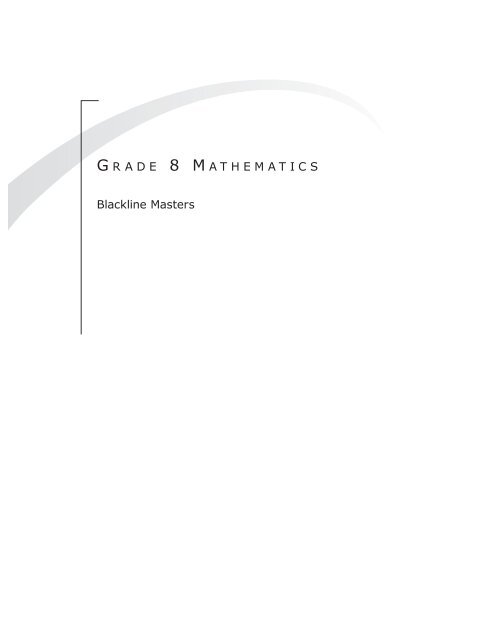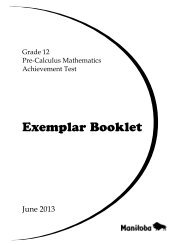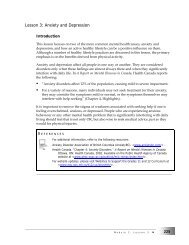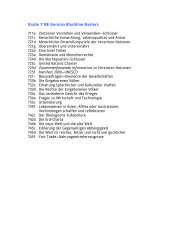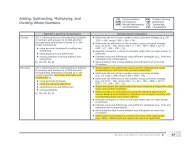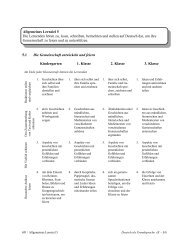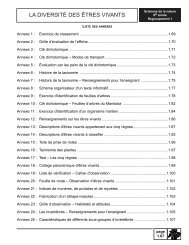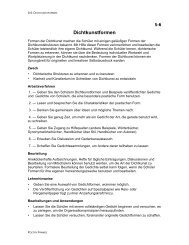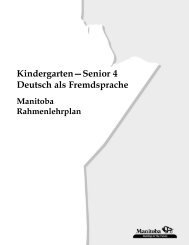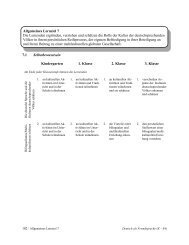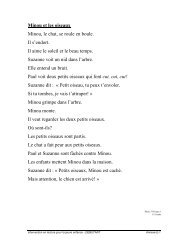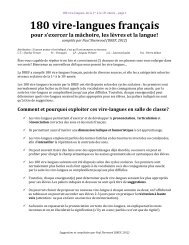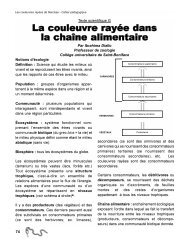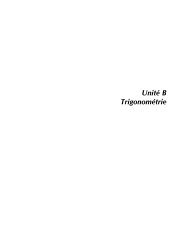G RADE 8 M ATHEMATICS Blackline Masters
G RADE 8 M ATHEMATICS Blackline Masters
G RADE 8 M ATHEMATICS Blackline Masters
Create successful ePaper yourself
Turn your PDF publications into a flip-book with our unique Google optimized e-Paper software.
G r a d e 8 M a t h e M a t i c s<br />
<strong>Blackline</strong> <strong>Masters</strong>
BLM 8.N.1.1: Determining Squares<br />
1. Determine the value of the following:<br />
7²<br />
10²<br />
2. Determine the area of the following squares:<br />
3 units<br />
8 units<br />
15²<br />
20²<br />
4 units 9 units
BLM 8.N.1.2: Determining Square Roots<br />
1. Determine the side length of the following squares:<br />
Area = 16 units 2<br />
Area = 49 units 2<br />
Area = 9 units 2<br />
Area = 121 units 2<br />
2. Determine the square root of the following:<br />
64 144 625 900
BLM 8.N.1.3: I Have . . . , Who Has . . . ?<br />
I have 25.<br />
Who has the square<br />
root of 36?<br />
I have 15.<br />
Who has the square<br />
root of 3?<br />
I have 12.2.<br />
Who has the square<br />
of 2?<br />
I have 6.<br />
Who has the square<br />
of a number between<br />
7 and 8?<br />
I have 1.7.<br />
Who has the square<br />
of 4?<br />
I have 4.<br />
Who has the square<br />
root of 9?<br />
I have 52.<br />
Who has the square<br />
root of 85?<br />
I have 16.<br />
Who has the square<br />
root of 144?<br />
I have 3.<br />
Who has the square<br />
of a number between<br />
11 and 12?<br />
I have 9.2.<br />
Who has the square<br />
of 1?<br />
I have 12.<br />
Who has the square<br />
of a number between<br />
9 and 10?<br />
I have 130.<br />
Who has the square<br />
root of 5?<br />
I have 1.<br />
Who has the square<br />
of a number between<br />
3 and 4?<br />
I have 90.<br />
Who has the square<br />
root of 150?<br />
I have 2.2.<br />
Who has the square<br />
of 7?<br />
continued
BLM 8.N.1.3: I Have . . . , Who Has . . . ? (continued)<br />
I have 49.<br />
Who has the square<br />
root of 64?<br />
I have 9.<br />
Who has the square<br />
of a number between<br />
8 and 9?<br />
I have 64.<br />
Who has the square<br />
of a number between<br />
4 and 5<br />
I have 8.<br />
Who has the square<br />
of 10?<br />
I have 70.<br />
Who has the square<br />
root of 10?<br />
I have 20.<br />
Who has the square<br />
root of 49?<br />
I have 100.<br />
Who has the square<br />
of a number between<br />
5 and 6?<br />
I have 3.2.<br />
Who has 9 squared?<br />
I have 7.<br />
Who has the square<br />
of 11?<br />
I have 30.<br />
Who has the square<br />
root of 121?<br />
I have 81.<br />
Who has the square<br />
root of 4?<br />
I have 121.<br />
Who has the square<br />
root of 40?<br />
I have 11.<br />
Who has the square<br />
of 3?<br />
I have 2.<br />
Who has the square<br />
of 8?<br />
I have 6.3.<br />
Who has 5 squared?
BLM 8.N.1.4: Pythagorean Theorem<br />
1. Find the measure of the missing side in the following triangles:<br />
a. b. 8 m<br />
4 cm<br />
6 cm<br />
c. d.<br />
10 cm<br />
9 cm<br />
2. Draw a triangle below. Use the Pythagorean theorem to determine whether your triangle is a<br />
right triangle.<br />
7 m<br />
7 m<br />
3 m
BLM 8.N.3.1: Percent Pre-Assessment<br />
1. Use the following grids to represent the following percents:<br />
a. 35%<br />
b. 78.5%<br />
c. 50%<br />
2. Complete the following chart.<br />
Fraction Decimal Percent<br />
3<br />
5<br />
4<br />
9<br />
0.75<br />
0.125<br />
22.5%<br />
3. During this basketball season, Ruan took 325 shots and made 120 baskets. What was his<br />
shooting percentage?<br />
4. A CD is offered at 25% discount. The original price was $25.50. What is the sale price of the<br />
CD?<br />
95%<br />
15%
BLM 8.N.3.2: Percent Self-Assessment<br />
Outcome Before Instruction After Instruction Evidence<br />
� Represent � Unable<br />
� Unable<br />
fractional � With assistance � With assistance<br />
percents � Consistently � Consistently<br />
between 1% � Confidently and � Confidently and<br />
and 100% on a<br />
hundreds grid.<br />
consistently<br />
consistently<br />
� Convert<br />
fractions to<br />
decimals.<br />
� Convert<br />
fractions to<br />
percents.<br />
� Converts<br />
decimals to<br />
fractions.<br />
� Convert<br />
decimals to<br />
percents.<br />
� Convert<br />
percents to<br />
fractions.<br />
� Convert<br />
percents to<br />
decimals.<br />
� Solve problems<br />
involving<br />
percents.<br />
� Unable<br />
� With assistance<br />
� Consistently<br />
� Confidently and<br />
consistently<br />
� Unable<br />
� With assistance<br />
� Consistently<br />
� Confidently and<br />
consistently<br />
� Unable<br />
� With assistance<br />
� Consistently<br />
� Confidently and<br />
consistently<br />
� Unable<br />
� With assistance<br />
� Consistently<br />
� Confidently and<br />
consistently<br />
� Unable<br />
� With assistance<br />
� Consistently<br />
� Confidently and<br />
consistently<br />
� Unable<br />
� With assistance<br />
� Consistently<br />
� Confidently and<br />
consistently<br />
� Unable<br />
� With assistance<br />
� Consistently<br />
� Confidently and<br />
consistently<br />
� Unable<br />
� With assistance<br />
� Consistently<br />
� Confidently and<br />
consistently<br />
� Unable<br />
� With assistance<br />
� Consistently<br />
� Confidently and<br />
consistently<br />
� Unable<br />
� With assistance<br />
� Consistently<br />
� Confidently and<br />
consistently<br />
� Unable<br />
� With assistance<br />
� Consistently<br />
� Confidently and<br />
consistently<br />
� Unable<br />
� With assistance<br />
� Consistently<br />
� Confidently and<br />
consistently<br />
� Unable<br />
� With assistance<br />
� Consistently<br />
� Confidently and<br />
consistently<br />
� Unable<br />
� With assistance<br />
� Consistently<br />
� Confidently and<br />
consistently
BLM 8.N.3.3: Percent Grids<br />
continued
BLM 8.N.3.3: Percent Grids (continued)<br />
continued
BLM 8.N.3.3: Percent Grids (continued)<br />
continued
BLM 8.N.3.3: Percent Grids (continued)
BLM 8.N.3.4: Percent Scenarios<br />
Explain what the following scenario statements mean and give reasons for your explanations.<br />
1. In the month of June, the school canteen sold 300% of the frozen yogourt it sold in the month<br />
of May.<br />
2. The Winnipeg Blue Bombers handed out T-shirts to the first 100 fans at the football game.<br />
This represented 1<br />
% of the fans who attended that game.<br />
2<br />
3. The school reached 150% of its goal in collecting food items for the local food hamper.<br />
4. Brendan scored 84.5% on his test.
BLM 8.N.3.5: Percent Savings<br />
The following problems involve percent savings. Answer the questions, showing your work on<br />
chart paper.<br />
1. The regular price of crackers is $2.99. The crackers are on sale for $1.99. To the nearest tenth<br />
of a percent, what is the percent savings?<br />
2. Pudding four-packs are on sale for $1.29. The regular price is $1.89. To the nearest tenth of a<br />
percent, what is the percent savings?<br />
3. Jumbo roll, two-ply bathroom tissue is on sale for $12.99. The regular price is $17.99. To the<br />
nearest tenth of a percent, what is the percent savings?<br />
4. The regular price of diapers is $18.99. They are on sale for $14.99. To the nearest tenth of a<br />
percent, what is the percent savings?<br />
5. Liquid soap is on sale for $1.79. The regular price is $2.49. To the nearest tenth of a percent,<br />
what is the percent savings?<br />
6. Cookies are on sale for $2.00. The regular price is $3.39. To the nearest tenth of a percent,<br />
what is the percent savings?<br />
7. The regular price of soup is $1.69 each. The soup is on sale at four cans for $5.00. To the<br />
nearest tenth of a percent, what is the percent savings for one can of soup?<br />
8. Boxes of chocolates are on sale for $12.99 for 725 g. The regular price is $17.99. To the<br />
nearest tenth of a percent, what is the percent savings?<br />
9. Instant coffee is on sale for $3.49. The regular price is $4.99. To the nearest tenth of a<br />
percent, what is the percent savings?<br />
10. Candles are on sale for $4.97. The regular price is $5.99. To the nearest tenth of a percent,<br />
what is the percent savings?
BLM 8.N.3.6: Final Cost<br />
Solve the following problems, showing your work on chart paper. In calculating the final cost,<br />
assume that PST is 7% and GST is 5%.<br />
1. Denim jeans cost $14.97. After PST and GST are included, what is the final cost of the<br />
jeans?<br />
2. A gaming system bundle costs $199.99. After PST and GST are included, what is the final<br />
cost of the bundle?<br />
3. Another gaming system bundle costs $299.99. After PST and GST are included, what is the<br />
final cost of the bundle?<br />
4. A cardigan costs $24.97. After PST and GST are included, what is the final cost of the<br />
cardigan?<br />
5. A leather purse costs $39.97. After PST and GST are included, what is the final cost of the<br />
purse?<br />
6. A men’s long-sleeved shirt costs $29.97. After PST and GST are included, what is the final<br />
cost of the shirt?<br />
7. A hoodie costs $24.97. After PST and GST are included, what is the final cost of the hoodie?<br />
8. A child’s snowsuit costs $74.97. After PST and GST are included, what is the final cost of<br />
the snowsuit?<br />
9. Leather gloves cost $19.97. After PST and GST are included, what is the final cost of the<br />
gloves?<br />
10. Men’s skate shoes cost $19.97. After PST and GST are included, what is the final cost of the<br />
skate shoes?
BLM 8.N.3.7: Percent Increase and Decrease<br />
Solve the following problems, showing your work on chart paper.<br />
1. The town of Mercury had a population of 15 000 people two years ago. Last year, the<br />
population grew 10%, and this year, the population grew another 15%. Elliot said that to<br />
determine the current population, you would have to calculate the percent increase<br />
separately. Max said you could combine the two percents to get the current population. Who<br />
is correct? Explain.<br />
2. Scott wants to travel to Jupiter City. He started calling around to see who had the best deal<br />
for a ticket to Jupiter City. Outer Sky Travel had a seat sale last week in which tickets to<br />
Jupiter City were 15% off the regular price of $135. They will now take an additional 10%<br />
off the sale price. Galaxy Way Travel also has a seat sale. Tickets are 25% off the regular<br />
price of $135. Which travel agency has the better seat sale for a ticket to Jupiter City?
BLM 8.N.4.1: Ratio Pre-Assessment<br />
1. Use pattern blocks to represent the following ratios. Show your work to the teacher before<br />
moving on to the next question.<br />
a. 3 trapezoids to 5 equilateral triangles<br />
b. 4 rhombuses to 6 equilateral triangles<br />
2. Use diagrams to represent the following ratios.<br />
a. 7 Xs to 3 Os<br />
b. 4 Os to 5 Xs<br />
3. Represent the following ratios symbolically.<br />
a. dogs to cats<br />
b. apples to bananas<br />
c. bikes to cars<br />
4. Solve the following problem. Show your thinking.<br />
If 1 out of every 4 students at Boulder School rides a bike to school and the rest of the bikes<br />
are driven by the students’ parents, how many bikes are at the bike rack during the day if<br />
there are 720 students who attend Boulder School?
BLM 8.N.4.2: Meaning of a<br />
b ?<br />
a<br />
Read each of the following scenarios and determine whether the fraction is representing a<br />
b<br />
fraction, rate, ratio, quotient, or probability.<br />
You must justify your thinking, record your thinking on chart paper, and be prepared to share<br />
your thinking with the class.<br />
3<br />
1. Jeremy has a chance of rolling an even number on a six-sided regular number cube.<br />
6<br />
2. Samantha travelled<br />
27 km<br />
3h<br />
on her bike.<br />
3<br />
3. Having three girls and five boys on the intramural volleyball team is shown as .<br />
5<br />
7<br />
4. Pedro scored on his math quiz.<br />
10<br />
3<br />
5. John ate of a bag of chips.<br />
4
BLM 8.N.4.3: Problem Solving<br />
Solve the following problems. Record your problem-solving process on chart paper, and be<br />
prepared to explain your results.<br />
1. Jordan divided her pie into eighths. Nicole divided her pie into fourths. Jordan’s family ate<br />
two-eighths of her pie. How many fourths of Nicole’s pie would have to be eaten to result in<br />
an equivalent amount of pie being eaten?<br />
2. If the ratio of basketball players to volleyball players at the Middle Years school is 5:3 and<br />
there are 112 basketball players, how many volleyball players are there?<br />
3. It was recently estimated by the Snoop Dog Pound that unregistered Snoop dogs outnumber<br />
registered ones by about eight to five. If there are a total of 2 054 Snoop dogs, about how<br />
many of them are registered?<br />
4. Kaden has just started his collection of plastic cars and obtained 20 new plastic cars. Eric has<br />
60 old plastic cars. Derek has 100 old plastic cars. If all their collections were combined,<br />
what would be the ratio of old plastic cars to new plastic cars? Write your answer in ratio<br />
form. Express your answer in its simplest form. Explain why it might be nice to have the<br />
ratio in its simplest form.<br />
5. SunnyTown had a great hockey team last year. The players outperformed their opponents in<br />
almost every category of play. One of their more impressive statistics was that, on average,<br />
they outscored their opponents by 3:1 in every game they played. If they scored an average<br />
of 6 goals per game, what was the average number of points scored by their opponents per<br />
game?<br />
6. Water is flowing into your sump pit at a rate of 3 cm per minute. The sump pump pumps it<br />
out at a rate of 1 mm per second. Will the pump be able to keep the water out of your<br />
basement? Explain.
BLM 8.N.6.1: Mixed Numbers and Improper Fractions<br />
Improper Fractions to Mixed Numbers<br />
Choose one of the following fractions and show, using words and diagrams, how to convert an<br />
improper fraction to a mixed number. Show that your answer is reasonable.<br />
8<br />
5<br />
15<br />
6<br />
23<br />
7<br />
Mixed Numbers to Improper Fractions<br />
Choose one of the following mixed numbers and show, using words and diagrams, how to<br />
convert a mixed number to an improper fraction. Show that your answer is reasonable.<br />
2<br />
2<br />
3<br />
4<br />
3<br />
5<br />
1<br />
4<br />
4
BLM 8.N.6.2: Mixed Number War
BLM 8.N.6.3: Decimal Addition Wild Card<br />
�<br />
+<br />
Round My Numbers My Partner’s Numbers<br />
E.g., 6 . 3 2 + 1 . 7 7 = 8 . 0 9 5 . 8 4 + 3 . 1 9 = 9 . 0 3<br />
1 . + . = . . + . = .<br />
2 . + . = . . + . = .<br />
3 . + . = . . + . = .<br />
4 . + . = . . + . = .<br />
5 . + . = . . + . = .<br />
6 . + . = . . + . = .<br />
7 . + . = . . + . = .<br />
8 . + . = . . + . = .<br />
9 . + . = . . + . = .<br />
�
BLM 8.N.6.4: Fraction Multiplication and Division<br />
Division Multiplication Pattern<br />
1 1<br />
÷ =<br />
2 2<br />
1 2<br />
● =<br />
2 1<br />
3 2<br />
÷ =<br />
4 4<br />
3 4<br />
● =<br />
4 2<br />
4 3<br />
÷ =<br />
5 5<br />
4 5<br />
● =<br />
5 3<br />
5 4<br />
÷ =<br />
6 6<br />
5 6<br />
● =<br />
6 4<br />
5 3<br />
÷ =<br />
8 8<br />
5 8<br />
● =<br />
8 3<br />
7 2<br />
÷ =<br />
10 10<br />
7 10<br />
● =<br />
10 2
BLM 8.N.6.5: Multiplying and Dividing Proper Fractions,<br />
Improper Fractions, and Mixed Numbers<br />
1. Multiply the following fractions symbolically.<br />
a.<br />
1 1<br />
4 6 =<br />
4 3<br />
� b.<br />
5 8 = �<br />
2. Multiply the following fractions symbolically.<br />
a.<br />
4 5<br />
3 2 =<br />
14 2<br />
� b.<br />
10 5 = �<br />
3. Multiply the following fractions symbolically.<br />
a.<br />
3 5<br />
3 3<br />
5 6 =<br />
1 2<br />
� b. 4 2<br />
2 3 = �<br />
4. Divide the following fractions symbolically.<br />
1 2<br />
a. ÷ =<br />
2 3<br />
5. Divide the following fractions symbolically.<br />
a.<br />
1 3<br />
b. ÷ =<br />
5 8<br />
18 5<br />
1 3<br />
÷ = b. ÷ =<br />
5 2<br />
5 8<br />
6. Divide the following fractions symbolically.<br />
1 2<br />
1 2<br />
a. 7 ÷ 4 =<br />
b. 2<br />
÷ 3 =<br />
3 3<br />
10 5
BLM 8.N.6.6: Fraction Operations<br />
1. Cyril is making cereal squares for his class party. His recipe calls for 1<br />
cup margarine to<br />
2<br />
make 12 squares. How much margarine will Cyril need if there are 36 people in his class<br />
(including students, the teacher, and educational assistants)?<br />
a. We believe we need to ____________________ in order to solve this problem. (Fill in<br />
the blank with one of the operations.)<br />
b. We think we need to ______________________ because ___________________<br />
c. Our solution is: (Show your work below. Include all steps.)<br />
d. We think our solution is reasonable because ______________________________<br />
2. Angie’s recipe for peanut butter cookies makes 24 cookies and uses 2<br />
cup peanut butter.<br />
3<br />
The only person in Angie’s family who likes peanut butter cookies is Angie, so she only<br />
wants to make 6 cookies. How much peanut butter will she need?<br />
a. We believe we need to ___________________ in order to solve this problem. (Fill in the<br />
blank with one of the operations.)<br />
b. We think we need to _____________________ because ____________________<br />
c. Our solution is: (Show your work below. Include all steps.)<br />
d. We think our solution is reasonable because ______________________________<br />
continued
BLM 8.N.6.6: Fraction Operations (continued)<br />
3. One-third of the class made bread with no sugar, one-third of the class made bread with no<br />
yeast, and one-third of the class made bread with all ingredients. The class consisted of<br />
63 students, of which five-sevenths were boys. The teacher chose the three groups to be as<br />
equal as possible in their boy–girl ratio. How many boys and girls were assigned to each<br />
kitchen?<br />
a. We believe we need to ____________________ in order to solve this problem. (Fill in<br />
the blank with one of the operations.)<br />
b. We think we need to _____________________ because ___________________<br />
c. Our solution is: (Show your work below. Include all steps.)<br />
d. We think our solution is reasonable because ______________________________<br />
4. Lindsay and Hailey each made a doghouse for their new puppies and then painted it. Lindsay<br />
used 1<br />
1 cans of paint. Hailey used<br />
4 1<br />
2 cans of pain. How many times as much paint did<br />
3<br />
Hailey use as Lindsay?<br />
a. We believe we need to ____________________ in order to solve this problem. (Fill in<br />
the blank with one of the operations.)<br />
b. We think we need to ______________________ because ___________________<br />
c. Our solution is: (Show your work below. Include all steps.)<br />
d. We think our solution is reasonable because ______________________________
BLM 8.N.7.1: Integer Pre-Assessment<br />
Concept Activity Pictorial Representation and Explanation<br />
Zero principle<br />
Adding<br />
integers with<br />
like signs<br />
Adding<br />
integers with<br />
opposite signs<br />
Model + 4 and –2<br />
in three different<br />
ways.<br />
Model (+3) + (+5)<br />
and (–2) + (–4)<br />
Model (+4) + (–3)<br />
and (–5) + (+2)<br />
continued
BLM 8.N.7.1: Integer Pre-Assessment (continued)<br />
Concept Activity Pictorial Representation and Explanation<br />
Subtracting<br />
integers with<br />
like signs<br />
when the first<br />
term is larger<br />
than the<br />
second term<br />
Subtracting<br />
integers with<br />
like signs<br />
when the first<br />
term is smaller<br />
than the<br />
second term<br />
Subtracting<br />
integers with<br />
opposite signs<br />
Model (+6) – (+2)<br />
and (–5) – (–3)<br />
Model (+2) – (+5)<br />
and (–1) – (–3)<br />
Model (–2) – (+3)<br />
and (+4) – (–5)
BLM 8.N.7.2: Solving Problems with Integers (A)<br />
Solve the following problems. Use integers to reflect each number. Be sure to show your<br />
thinking.<br />
1. The morning temperature on October 21 in Winnipeg was 4°C. The temperature started to<br />
drop continuously 3°C each hour for the next five hours. What was the total change in<br />
temperature? What was the final temperature?<br />
2. It was a warm spring day in Manitoba and a snow bank along the Trans Canada Highway<br />
melted 4 cm each hour. If the snow continued to recede at the same rate, how far would it<br />
have receded after 7 hours?<br />
3. Samuel liked to play arcade games with his friends. Samuel played 10 different games one<br />
Saturday night. Each game cost $2.00. How much money did Samuel spend that night?<br />
4. Pete hired Alvin’s Drilling to drill a well on his property. If Alvin’s Drilling drilled at a rate<br />
of 2 m/min. and had the well drilled after 90 minutes, how deep would the well be?<br />
5. Jordy donates $10.00 per month to her local food bank. How much does Jordy donate to the<br />
food bank in one year?
BLM 8.N.7.3: Solving Problems with Integers (B)<br />
Solve the following problems. Use integers to reflect each number. Be sure to show your<br />
thinking.<br />
1. Barry goes to movies only on Tuesday nights because you can see a movie and get popcorn<br />
and a drink all for $10. Barry borrows $10 from his mom every Tuesday to go to the movies.<br />
If Barry owes his mom $80 for the movies he has gone to, how many movies did he see?<br />
2. Sandy and her four sisters decided to go together to purchase their mom a birthday present.<br />
The gift, taxes included, totalled $120, which Sandy put on her credit card. How much does<br />
each sister owe Sandy for their mom’s birthday present?<br />
3. Joanne hired Alvin’s Drilling to drill a well on her property. If Alvin’s Drilling took<br />
60 minutes to drill a 240 m well, what was the rate of drilling?<br />
4. Jessica borrowed $75 from her dad to purchase a concert ticket. She gets paid at work every<br />
two weeks. If she pays her dad $15 a paycheque, how many pay periods will it take Jessica to<br />
pay off her $75 debt?<br />
5. Jordan and Steve love to scuba dive. They went diving off the coast of Cancun. If they took<br />
15 minutes to dive 90 metres, how far did they dive per minute?
BLM 8.N.7.4: Solving Problems with Integers (C)<br />
Solve the following problems. Use integers to reflect each number. Be sure to show your<br />
thinking.<br />
1. The daily high temperatures for Winnipeg for the first seven days of 2010 were:<br />
–21.6°C, –22.4°C, –17.1°C, –15.0°C, –13.1°C, –13.7°C, –21.1°C.<br />
What was the mean temperature for the first week of January 2010 in Winnipeg?<br />
2. The unemployment rate for Manitoba and Canada from 2002 to 2008 is listed below. What is<br />
the mean unemployment rate for Manitoba and Canada over the seven years listed?<br />
Unemployment Rate (%)—Seasonally Adjusted*<br />
2002 2003 2004 2005 2006 2007 2008<br />
Manitoba 5.1% 5.0% 5.3% 4.8% 4.3% 4.4% 4.2%<br />
Canada 7.7% 7.6% 7.2% 6.8% 6.3% 6.0% 6.1%<br />
*Source: Manitoba Bureau of Statistics, August 2009. Cited on the Manitoba Entrepreneurship, Training and<br />
Trade website at (13 Oct. 2010).<br />
Used with permission.<br />
3. Lucas earns $30 a week in the winter from shovelling snow. Every week he spends $10,<br />
saves $15, and gives the rest to his mom to repay a $90 loan. After 16 weeks, how much has<br />
Lucas spent, how much has he saved, and how much does he still owe his mom?<br />
4. Patricia hired a taxi to take her to the airport. Patricia had to pay the driver a $10 fee just for<br />
renting the taxi and another $1 per km to get from her house to the airport. If Patricia lives<br />
12 kilometres from the airport, how much did she have to pay the taxi driver?<br />
5. At a used book sale, Jennifer sold 3 of her books for $2.00 each, 4 of her books for $3.00<br />
each, and her atlas for $5.00. She also bought 6 books for $1.50 each. How much money did<br />
Jennifer have when she left the book sale?
BLM 8.N.7.5: Number Line Race<br />
Numbers Rolled Numbers Found<br />
continued
BLM 8.N.7.5: Number Line Race (continued)<br />
– +10<br />
– +9<br />
– +8<br />
– +7<br />
– +6<br />
– +5<br />
– +4<br />
– +3<br />
– +2<br />
– +1<br />
– 0<br />
– –1<br />
– –2<br />
– –3<br />
– –4<br />
– –5<br />
– –6<br />
– –7<br />
– –8<br />
– –9<br />
– –10
BLM 8.PR.1.1: Patterns Pre-Assessment<br />
1. Draw and label the next three figures of the following pattern.<br />
Figure 1 Figure 2 Figure 3<br />
2. Describe the pattern.<br />
3. Construct a table of values from the pattern.<br />
continued
BLM 8.PR.1.1: Patterns Pre-Assessment (continued)<br />
4. Construct a graph for the pattern.<br />
5. Write an algebraic expression for the pattern.<br />
6. Use an equation to find the number of dots in the 15th figure.
BLM 8.PR.1.2: Determine the Missing Values<br />
Determine the missing values in the ordered pairs.<br />
1. Fill in the missing values in the following table of values.<br />
0 1 3<br />
0 1 4<br />
2. For the equation y = –2x + 3, find the missing values in the following ordered pairs.<br />
a. (0, y) b. (x, 1) c. (5, y) d. (x, –1)<br />
3. Fill in the missing values in the following table of values.<br />
1 3<br />
7<br />
4<br />
5 19<br />
4. For the equation y = 3x + 1, find the missing values in the following ordered pairs.<br />
a. (0, y) b. (x, 1) c. (5, y) d. (x, –1)
BLM 8.PR.1.3: Break the Code<br />
What do you say when you see an empty parrot cage?<br />
Use the following equation, the ordered pairs, and the code below to help<br />
answer the question.<br />
y = 2x – 3<br />
_______ _______ _______ _______ _______ _______ _______<br />
(x, 51) (14, y) (11, y) (x, 87) (6, y) (x, 47) (x, 43)<br />
A B C D E F G H I J K L M<br />
–8 –1 1 3 35 –7 9 21 –13 15 7 19 –21<br />
N O P Q R S T U V W X Y Z<br />
23 25 27 –9 31 53 –5 37 6 14 43 45 –10
BLM 8.PR.1.4: Linear Relations<br />
For each of the following problems, create a table of values to show the relationship, and<br />
construct a graph from the ordered pairs.<br />
1. Grapefruits are $1.00 per grapefruit.<br />
2. Movie tickets are $9.00 per ticket.<br />
3. y = 2x + 4<br />
x<br />
4. y = + 3<br />
2
BLM 8.PR.1.5: Graphs<br />
Charges ($)<br />
11<br />
10<br />
9<br />
8<br />
7<br />
6<br />
5<br />
4<br />
3<br />
2<br />
1<br />
Babysitting Costs<br />
X<br />
0<br />
0 1 2 3 4 5<br />
Time (h)<br />
continued
Area (cm 2 )<br />
BLM 8.PR.1.5: Graphs (continued)<br />
12<br />
11<br />
10<br />
9<br />
8<br />
7<br />
6<br />
5<br />
4<br />
3<br />
2<br />
1<br />
X<br />
X<br />
X<br />
Triangle Area<br />
X<br />
0 1 2 3 4 5 6 7 8 9<br />
X<br />
Base (cm)<br />
: h = 4<br />
X : h = 3
BLM 8.PR.2.1: Algebra Pre-Assessment<br />
Complete the following table. Remember to check your work.<br />
Problem<br />
n + 7 = 15<br />
t – 4 = 3<br />
4x = 12<br />
p<br />
= 2<br />
3<br />
Concrete<br />
Representation and<br />
Solution<br />
(When you have completed<br />
this column, show it to the<br />
teacher before moving on<br />
to the next two columns.)<br />
Pictorial<br />
Representation<br />
and Solution<br />
Symbolic<br />
Representation<br />
and Solution
BLM 8.PR.2.2: Solving Equations Symbolically<br />
Solve the following equations.<br />
Equation Solution Check<br />
− x<br />
= –5<br />
4<br />
6t = –54<br />
14n + 12 = 40<br />
3b<br />
= –6<br />
− 5<br />
4a – 5 = 23<br />
continued
BLM 8.PR.2.2: Solving Equations Symbolically (continued)<br />
Equation Solution Check<br />
–7(n + 4) = –42<br />
4(s – 3) = –4<br />
5(b + 13) = 25
BLM 8.PR.2.3: Algebra Match-up<br />
y + 4 = 9<br />
9 + y = 2<br />
3y = 12<br />
–2y + 1 = 5<br />
y = 5<br />
y = –7<br />
y = 4<br />
y = –2<br />
2 = 2(y + 4)<br />
–y + 3 = 4 – 8<br />
–(5 + y) = 7<br />
5 = 3y + 8<br />
y = –3<br />
y = 7<br />
y = –12<br />
y = –1<br />
continued
BLM 8.PR.2.3: Algebra Match-up (continued)<br />
y + 3 = 4<br />
13 + y = 9<br />
–3y = 15<br />
–2y + 19 = 3<br />
y = 1<br />
y = –4<br />
y = –5<br />
y = 8<br />
4 = 2(y – 4)<br />
y + 5 = 1 – 9<br />
–(3 + y) = 8<br />
8 = 3y + 8<br />
y = 6<br />
y = –13<br />
y = –11<br />
y = 0
BLM 8.PR.2.4: Analyzing Equations<br />
Analyze the following solutions to determine whether they are correct or incorrect.<br />
If a solution is incorrect, identify the error, and then rewrite the solution on chart paper showing<br />
the correct method for solving the equation.
BLM 8.PR.2.5: Analyzing Equations Assessment<br />
Analyze the following solutions to determine whether they are correct or incorrect.<br />
If a solution is incorrect, identify the error, and then rewrite and solve the equation correctly.
BLM 8.PR.2.6: Solving Problems Using a Linear Equation<br />
Determine methods of solving the following problems using a linear equation. Be prepared to<br />
present your solution methods to the class.<br />
1. Joe is 16 years older than Bill. Sam is the same age as Bill. Their combined age is 79. How<br />
old are Joe, Bill, and Sam?<br />
2. Olympia High School sold advance tickets to their high school musical for $3.00 per ticket.<br />
Tickets purchased at the door were sold for $5.00 per ticket. How many tickets were sold in<br />
advance if 20 tickets were sold at the door and $340.00 were collected in total?<br />
3. Jenna has two jobs. At her job as a word processor, she earns $8.50/h. At her job as a cashier,<br />
she makes $8.75/h. Jenna worked 15 hours as a word processor this week and earned $140.00<br />
as a cashier. If she earned $267.50 this week, how many hours did she work as a cashier?
BLM 8.SS.2.1: Measurement Pre-Assessment<br />
Calculate the following. Show your thinking.<br />
d = 20<br />
6 cm<br />
5 cm<br />
15 cm<br />
7 cm<br />
4 cm<br />
5 cm<br />
r = 3 cm<br />
8 cm<br />
Area = _________<br />
Circumference = _________<br />
Volume = ________<br />
Area = ________<br />
Area = ________
BLM 8.SS.2.2: Nets of 3–D Objects<br />
continued
BLM 8.SS.2.2: Nets of 3–D Objects (continued)<br />
continued
BLM 8.SS.2.2: Nets of 3–D Objects (continued)<br />
continued
BLM 8.SS.2.2: Nets of 3–D Objects (continued)<br />
continued
BLM 8.SS.2.2: Nets of 3–D Objects (continued)<br />
continued
BLM 8.SS.2.2: Nets of 3–D Objects (continued)
BLM 8.SS.2.3: 3–D Objects<br />
Cube<br />
Trapezoid<br />
prism<br />
Triangular<br />
pyramid<br />
Cylinder<br />
Rectangular<br />
prism<br />
Square<br />
pyramid<br />
Triangular<br />
prism
BLM 8.SS.2.4: Matching<br />
Match the following<br />
nets with their names.<br />
� cube<br />
� triangular prism<br />
� cylinder<br />
� rectangular prism<br />
� hexagonal prism<br />
� rectangular pyramid<br />
� triangular pyramid
BLM 8.SS.3.1: Nets
BLM 8.SS.3.2: Surface Area Problems<br />
Solve the following surface area problems and record your answers on chart paper. Explain what<br />
method you chose for solving the problem, why you chose that method, and why you think your<br />
answer is reasonable. Be prepared to present your solution methods to the class.<br />
1. Samantha’s mom loves chocolate bars, so Samantha bought her mom a chocolate bar of the<br />
following size.<br />
15 cm<br />
What is the minimal amount of wrapping paper Samantha will need to wrap her mom’s<br />
present? Calculate your answer to the nearest tenth of a square centimetre.<br />
2. Joe’s pizzeria sells individual slices of pizza. How much cardboard would you need to cover<br />
a piece of pizza of the following size if the height of the box must be 3 cm tall to<br />
accommodate the height of the pizza? Calculate your answer to the nearest tenth of a<br />
square centimetre.<br />
20 cm<br />
15 cm<br />
15 cm<br />
20 cm<br />
30 cm<br />
3. Jamil’s grandmother is coming to live with his family. Jamil’s grandmother is quite elderly<br />
and needs a wheelchair to enter and exit the house. How much wood does Jamil’s dad have<br />
to buy to build the following ramp? Calculate your answer to the nearest hundredth of a<br />
square metre.<br />
1.8 m<br />
Chocolate<br />
3 cm<br />
6.2 m<br />
6.5 m<br />
1.5 m<br />
continued
BLM 8.SS.3.2: Surface Area Problems (continued)<br />
4. Hannah’s mom bought Hannah a new alarm clock radio for her birthday. The alarm clock<br />
radio came in a box with the following dimensions. What is the minimal amount of wrapping<br />
paper Hannah’s mom will need to wrap Hannah’s present? Calculate your answer to the<br />
nearest tenth of a square centimetre.<br />
25 cm<br />
15 cm<br />
45 cm<br />
5. Rashedeh wants to paint her bedroom walls and ceiling. How much paint would she need<br />
if two walls have the dimensions of 3.5 m × 2.8 m, two walls have the dimensions of<br />
2.4 m × 2.8 m, and the ceiling has a dimension of 3.5 m × 2.4 m, and one litre of paint<br />
covers 8.5 square metres?<br />
6. Jordan wants to sand the rust off the following rain barrel, including the lid. How much area<br />
does he need to sand? Calculate your answer to the nearest tenth of a square metre.<br />
0.75 m<br />
1.5 m<br />
7. Steve wants to design a cylinder that will hold 10 arrows. His design looks like this.<br />
8 cm<br />
45 cm<br />
How much cardboard will he need to make his cylinder? Calculate your answer to the nearest<br />
tenth of a centimetre.
BLM 8.SS.4.1: Volume Problems<br />
You will be solving volume problems that involve right cylinders and right prisms. Record your<br />
answers on chart paper. Explain what method you chose for solving each problem, why you<br />
chose that method, and why you think your answer is reasonable. Be prepared to present your<br />
problem-solving methods to the class.<br />
1. Determine the volume of the following rectangular prisms.<br />
Area = 1200 cm²<br />
12 cm<br />
2. Determine the volume of the following triangular prisms.<br />
Area = 625 cm²<br />
4 cm<br />
3. Determine the volume of the following right cylinders.<br />
Area = 72 cm²<br />
8 cm<br />
3.5 m<br />
8 cm<br />
15 m<br />
12 cm<br />
12 cm<br />
2.25 m<br />
1.5 m<br />
r = 4 m
BLM 8.SS.6.1: Coordinate Image<br />
A B<br />
C D<br />
–8 –7 –6 –5 –4 –3 –2 –1<br />
–1<br />
1 2 3 4 5 6<br />
7<br />
6<br />
5<br />
4<br />
3<br />
2<br />
1<br />
–2<br />
–3<br />
–4<br />
–5<br />
–6
BLM 8.SS.6.2: Tessellating the Plane<br />
Shape Sum of the interior angles of<br />
the common vertices<br />
Square<br />
Equilateral triangle<br />
Regular hexagon<br />
Regular pentagon<br />
Regular octagon<br />
Rhombus<br />
Rectangle<br />
Parallelogram<br />
Isosceles triangle<br />
Irregular pentagon<br />
Does the shape tessellate<br />
the plane?
BLM 8.SS.6.3: Tessellation Slideshow<br />
Determine which transformation was used for each of the following tessellations, which<br />
were created by Manitoba students.<br />
Tessellation #1
BLM 8.SS.6.3: Tessellation Slideshow (continued)<br />
Tessellation #2
BLM 8.SS.6.3: Tessellation Slideshow (continued)<br />
Tessellation #3
BLM 8.SS.6.3: Tessellation Slideshow (continued)<br />
Tessellation #4
BLM 8.SS.6.3: Tessellation Slideshow (continued)<br />
Tessellation #5
BLM 8.SS.6.3: Tessellation Slideshow (continued)<br />
Tessellation #6
BLM 8.SS.6.3: Tessellation Slideshow (continued)<br />
Tessellation #7
BLM 8.SS.6.3: Tessellation Slideshow (continued)<br />
Tessellation #8
BLM 8.SS.6.3: Tessellation Slideshow (continued)<br />
Tessellation #9
BLM 8.SS.6.3: Tessellation Slideshow (continued)<br />
Tessellation #10
BLM 8.SS.6.4: Tessellation Recording Sheet<br />
Recording Sheet for Tessellation Slide Show<br />
Tessellation<br />
Transformation Used to Create Tessellation<br />
Number<br />
1<br />
2<br />
3<br />
4<br />
5<br />
6<br />
7<br />
8<br />
9<br />
10
BLM 8.SS.6.5: Tessellation Transformation<br />
1. Identify which transformations were used<br />
for this tessellation. Justify your response.<br />
2. Identify which transformations were used<br />
for this tessellation. Justify your response.
BLM 8.SP.1.1: Data Analysis Pre-Assessment<br />
Read the following scenarios and indicate whether the statements are true or false.<br />
� Fill out the Start column at the beginning of your work with data.<br />
� Fill out the End column at the end of your work with data.<br />
If you select false, explain why in the space provided.<br />
Scenario<br />
1. You have asked all students in the class to<br />
identify their favourite search engine. The data<br />
should be displayed on a broken line graph.<br />
2. A circle graph must be filled up entirely, with<br />
no empty “pie pieces.”<br />
3. 25% of a circle would be 60 o .<br />
4. The intervals on the bar graph below are<br />
properly spaced.<br />
5. In the following circle graph representing<br />
100 people, about 25 of them have cats.<br />
True or False<br />
Start End<br />
Explanation
BLM 8.SP.1.2: Data<br />
Create a bar graph, a line graph, and a circle graph for each set of data presented below.<br />
1. The following are average masses of some North American animals when they are<br />
full-grown.<br />
� Arctic wolf: 80 kg<br />
� Black bear: 135 kg<br />
� Bobcat: 9 kg<br />
� Grizzly bear: 450 kg<br />
� Mule deer: 90 kg<br />
2. The following is Tani’s heart rate during an eight-minute fitness test (beep test).<br />
Heart Rate<br />
(beats/minute)<br />
70<br />
120<br />
123<br />
125<br />
126<br />
127<br />
142<br />
144<br />
145<br />
146<br />
148<br />
155<br />
157<br />
158<br />
158<br />
159<br />
165<br />
167<br />
168<br />
169<br />
171<br />
183<br />
185<br />
186<br />
188<br />
189<br />
193<br />
195<br />
197<br />
198<br />
199<br />
Time<br />
(seconds)<br />
0<br />
30<br />
30<br />
30<br />
30<br />
30<br />
25<br />
25<br />
25<br />
25<br />
25<br />
20<br />
20<br />
20<br />
20<br />
20<br />
15<br />
15<br />
15<br />
15<br />
15<br />
10<br />
10<br />
10<br />
10<br />
10<br />
5<br />
5<br />
5<br />
5<br />
5<br />
continued
BLM 8.SP.1.2: Data (continued)<br />
3. The following is Juan’s heart rate during a 10-minute cardio test on the treadmill.<br />
Heart Rate<br />
(beats/minute)<br />
70<br />
80<br />
90<br />
95<br />
100<br />
110<br />
110<br />
115<br />
110<br />
100<br />
100<br />
Time<br />
(minutes)<br />
0<br />
1<br />
2<br />
3<br />
4<br />
5<br />
6<br />
7<br />
8<br />
9<br />
10<br />
4. On a typical week day, Henry spends his time doing the following:<br />
� Watching TV and using the computer: 10%<br />
� At school: 25%<br />
� Doing homework: 5%<br />
� Sleeping: 33.3 % %<br />
� Hanging out with friends: 10%<br />
� Reading: 5%<br />
� Eating: 5%<br />
� Other: 6.6 %
BLM 8.SP.1.3: Graph Samples<br />
Sample 1<br />
continued
BLM 8.SP.1.3: Graph Samples (continued)<br />
Sample 2<br />
continued
BLM 8.SP.1.3: Graph Samples (continued)<br />
Sample 3<br />
Grade 5<br />
Grade 6<br />
Grade 7<br />
Grade 8<br />
Grade 5<br />
Grade 6<br />
Grade 7<br />
Grade 8<br />
represents 25 pets<br />
represents 25 pets<br />
represents 25 pets<br />
represents 25 pets<br />
represents 25 pets<br />
Types of Pets Owned by Students at<br />
Twin Sisters Middle Years School<br />
Types of Pets Owned by Students at<br />
Twin Sisters Middle Years School
BLM 8.SP.2.1: Probability Pre-Assessment<br />
Find out what you already know about probability by responding to the following.<br />
1. Emma and her mom are playing a number cube game and it is Emma’s turn to roll the<br />
number cube. If she can roll a 5, she will win the game. Emma knows that the chances of<br />
rolling a 5 are pretty small—in fact only 1 in 6. Explain, using words and diagrams, whether<br />
Emma is correct.<br />
2. Write P(5) in as many ways as you can.
BLM 8.SP.2.2: Tree Diagram<br />
Use a tree diagram to organize the outcomes for the following.<br />
1. Sam rolls a 12-sided number cube at the same time that Jenna spins a four-sectioned spinner<br />
with the letters L, O, V, and E. Determine all possible outcomes if Sam and Jenna complete<br />
the task at the same time.<br />
2. State the following probabilities: P(1, L), P(even, O), P(odd, vowel).
BLM 8.SP.2.3: Table<br />
Use a table to organize the outcomes for the following.<br />
1. Jackson spins a three-sectioned spinner with the letters R, U, and N, and Roberta flips a<br />
nickel. Determine all possible outcomes if Jackson and Roberta complete the task at the same<br />
time.<br />
2. State the following probabilities: P(R, Heads), P(consonant, T).
BLM 8.SP.2.4: Combinations<br />
Determine the number of possible outcomes for each combination given in the chart below.<br />
Number of<br />
Choices for<br />
Item 1<br />
Number of<br />
Choices for<br />
Item 2<br />
Number of<br />
Choices for<br />
Item 3<br />
2 pasta dishes 2 meat dishes None<br />
4 types of shoes 2 types of socks None<br />
3 types of<br />
sandwiches<br />
2 types of fruit None<br />
2 types of coats 3 styles of hats None<br />
4 models of cars 2 models of trucks 3 models of vans<br />
Outcomes
BLM 8.SP.2.5: Probability Problems<br />
Solve the following probability problems and be prepared to present your solution<br />
strategies to the class.<br />
1. You roll a six-sided number cube that has the numbers 2, 4, 6, 8, 10, and 12 on it.<br />
You spin a four-sectioned spinner that has the letters B, L, U, and E on it. Determine<br />
P(4 and vowel).<br />
2. You flip a coin and spin a five-sectioned spinner that has the colours red, yellow,<br />
blue, green, and orange on it. Determine P(heads and red).<br />
3. You flip a coin and spin a six-sectioned spinner with the letters O, R, A, N, G, and E<br />
on it. Determine P(heads and O).<br />
4. You roll a regular number cube and spin a four-sectioned spinner with the letters T,<br />
R, E, and E on it. Determine P(4 and E).<br />
5. You roll a regular number cube and flip a coin. Determine P(3 or less and tails).<br />
6. You roll a six-sided number cube that has the numbers 2, 4, 6, 8, 10, and 12 on it.<br />
You roll another six-sided cube that has the numbers 1, 3, 5, 7, 9, and 11. Determine<br />
P(sum is even number) and P(sum is less than 12).
BLM 8.SP.2.6: Probability Problem Practice<br />
Solve the following probability problems and be prepared to present your solution strategies.<br />
1. What is the probability of landing on tails for a toss coin and rolling a 2 on a six-sided<br />
number cube?<br />
2. What is the probability of pulling two red cards out of a deck (assuming you replace them<br />
after each pick)?<br />
3. What is the probability of rolling a 6 in two rolls of a six-sided number cube?<br />
4. What is the probability of choosing a 3 from a deck of cards and then choosing an ace<br />
(assuming you replace the card after the first pick)?<br />
5. A drawer holds five pairs of socks in five different colours: black, red, blue, white, and<br />
purple. You want to wear the white socks. You reach into the drawer in the dark.<br />
a. If the socks are bundled together as pairs, what is the probability of pulling the white ones<br />
on one try? on two tries? (Assume you put the socks back after each try.)<br />
b. If the socks are not bundled together, what is the probability of pulling a white sock on<br />
the first try? on two tries?<br />
6. A card is chosen randomly from a deck. What is the probability of choosing a face card each<br />
time (assuming you replace the card after each draw)?<br />
7. A jar holds 10 red, 10 green, 12 yellow, and 4 blue gum balls. You reach into the jar and<br />
randomly pull out one gum ball. After replacing it, you choose a second one. What is the<br />
probability of choosing a blue and a yellow gum ball?<br />
8. If a survey at school says that 9 out of 10 students like math, what is the probability that 3<br />
students randomly chosen in the hall like math?<br />
9. You are flipping a coin and throwing a six-sided number cube. What does P(H, 5) mean?<br />
Use a tree diagram to determine the probability of these independent events.<br />
10. Use a tree diagram to determine the probability of tossing heads if you toss a coin three<br />
times.<br />
11. The local ice cream shop offers four types of cones: sugar, waffle, standard, and chocolate<br />
dipped. You can have gelato, sorbet, frozen yogourt, or ice milk, each in four different<br />
flavours: chocolate, vanilla, strawberry, and maple walnut. How many different<br />
combinations are there? If the clerk randomly makes you a cone, what is the probability of it<br />
being a strawberry sorbet in a waffle cone?


